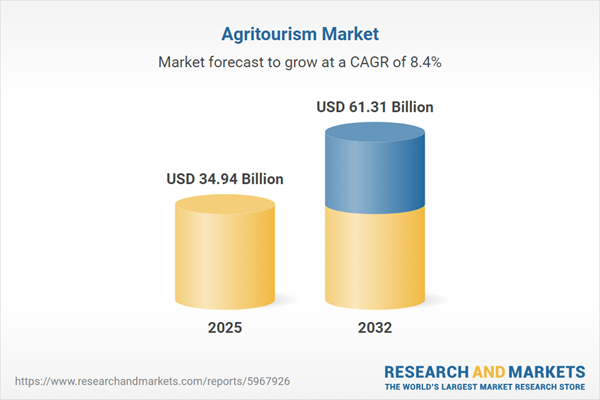Speak directly to the analyst to clarify any post sales queries you may have.
The agritourism market is rapidly evolving, shaped by the intersection of rural revitalization, changing traveler expectations, and expanded digital engagement. Senior decision-makers require a clear perspective on this market’s size, principal growth drivers, and how shifting consumer and policy dynamics are redefining opportunities.
Market Snapshot: Agritourism Market Size and Growth Trajectory
The Agritourism Market grew from USD 32.23 billion in 2024 to USD 34.94 billion in 2025. It is expected to continue growing at a CAGR of 8.36%, reaching USD 61.31 billion by 2032. These figures reflect the market’s resilience and ongoing appeal within the travel and tourism industry, highlighting sustained investment and demand across major regions.
Scope & Segmentation: Comprehensive View of the Agritourism Market
This report analyzes current and emerging market trends, segmentation, and regional activity to provide a holistic understanding for business leaders.
- Accommodation Type: Farm stays (luxury and standard), glamping (cabins and tents), guesthouses, ranch stays (dude and working ranch formats).
- Activity Type: Events & festivals, farm tours, U-pick produce, guided workshops and classes (culinary, craft).
- Booking Channel: Direct bookings (phone, property website), online travel agencies, travel agents.
- Purpose: Corporate retreats, educational visits (agriculture training, school field trips), leisure trips, special events (family reunions, weddings).
- Age Group: 18–34, 35–54, 55+, under 18.
- Geographic Coverage: Americas (including North America and Latin America); Europe, Middle East & Africa; Asia-Pacific (covering primary and secondary markets within each region).
- Key Companies Analyzed: Leading international and regional operators, digital platforms, and agritourism associations with a focus on innovation and strategic partnerships.
Agritourism Market: Key Takeaways for Senior Decision-Makers
- Agritourism operators are embracing digital innovation, integrating mobile apps and virtual tours to enhance visitor engagement and streamline booking processes.
- Sustainability practices—such as regenerative agriculture and renewable energy adoption—are shifting from trend to operational necessity, distinguishing environmentally responsible providers.
- Flexible pricing strategies and bundled offerings mitigate rising input costs and accommodate shifting visitor price sensitivity.
- Multi-generational appeal and diverse program design drive inclusive experiences, requiring a balance between cultural, educational, and leisure offerings.
- Strategic alliances support expanded reach, particularly through partnerships between small family-owned farms, tourism boards, and digital platforms.
Tariff Impact: Navigating Policy-Driven Shifts
Recent United States tariffs on imported equipment and hospitality materials have increased costs for many agritourism providers. Response strategies include sourcing domestically, investing in refurbished assets, and developing collective purchasing models to secure resources efficiently. These adaptations allow operators to preserve guest experience quality while maintaining cost controls.
Methodology & Data Sources
This analysis uses a mixed-methods approach including primary interviews with operators and sector experts, site visits, academic review, and data triangulation across qualitative and quantitative sources to ensure reliable, actionable insights.
Why This Report Matters: Strategic Value for Industry Leaders
- Enables proactive planning by revealing key shifts in consumer preferences, technology adoption, and regulatory influences across global markets.
- Delivers actionable recommendations for resilience, differentiation, and sustainable growth based on tested case studies and market-validated strategies.
Conclusion
The agritourism market’s transformation is powered by digital advancements, adaptive business strategies, and evolving guest expectations. Decision-makers equipped with these insights are well-positioned to drive innovation, deepen market engagement, and foster sustainable rural tourism growth.
Additional Product Information:
- Purchase of this report includes 1 year online access with quarterly updates.
- This report can be updated on request. Please contact our Customer Experience team using the Ask a Question widget on our website.
Table of Contents
3. Executive Summary
4. Market Overview
7. Cumulative Impact of Artificial Intelligence 2025
Companies Mentioned
The companies profiled in this Agritourism market report include:- Airbnb, Inc.
- Expedia Group, Inc.
- Booking Holdings, Inc.
- Association Gîtes de France
- Hipcamp, Inc.
- Harvest Hosts, Inc.
- Outdoorsy, Inc.
- Agriturismi Italiani S.r.l.
- Farm Stay UK Ltd.
- Rural Vacations Pty Ltd
Table Information
| Report Attribute | Details |
|---|---|
| No. of Pages | 197 |
| Published | November 2025 |
| Forecast Period | 2025 - 2032 |
| Estimated Market Value ( USD | $ 34.94 Billion |
| Forecasted Market Value ( USD | $ 61.31 Billion |
| Compound Annual Growth Rate | 8.3% |
| Regions Covered | Global |
| No. of Companies Mentioned | 11 |









